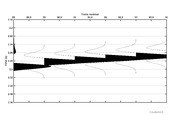Simulation of seismic attributes for earth models with different continuity properties
Master thesis

Permanent lenke
https://hdl.handle.net/1956/21025Utgivelsesdato
2019-11-21Metadata
Vis full innførselSamlinger
- Master theses [106]
Sammendrag
The combination of kinematic and dynamic ray tracing has been used since the 1970s for simulation (modelling) of seismic energy in the subsurface. Kinematic/dynamic ray tracing is used to simulate the travel time, amplitude and wavefront curvature of a seismic wave— these results are typically presented in the form of curves, maps or synthetic seismograms. Kinematic/dynamic ray tracing is known as a flexible and fast method with the advantage of allowing the user to choose which parts of the wavefield to be simulated. For calculation of amplitudes using dynamic ray tracing, the second-order derivatives of the velocity field must be known. As a consequence, the function representing the velocity field must be, as a minimum, C2 continuous, and this is why cubic splines traditionally has been used. In this study, I test the use of the quintic (fifth degree) B-spline representation. The main objective is to examine whether a quintic B-spline can make kinematic and dynamic ray tracing more robust with respect to local variations in the velocity field. I have done tests of direct ray tracing and two-point ray tracing in the Marmousi model and in a salt model. Both models were exposed to different degrees of smoothing. I compare the results obtained using the cubic and the quintic B-spline representations. For each representation I calculated a number of ray paths, travel times, amplitudes and seismograms, and I monitored the computation times. The results show that for a model with a relatively strong local velocity variation, a quintic representation provides a considerably higher degree of robustness for two-point ray tracing. For models with a higher degree of smoothness, I observe only small differences in the modelling results for the cubic and quintic representations. The quintic B-spline gives increased computation time, but on the other hand a general improvement in robustness.